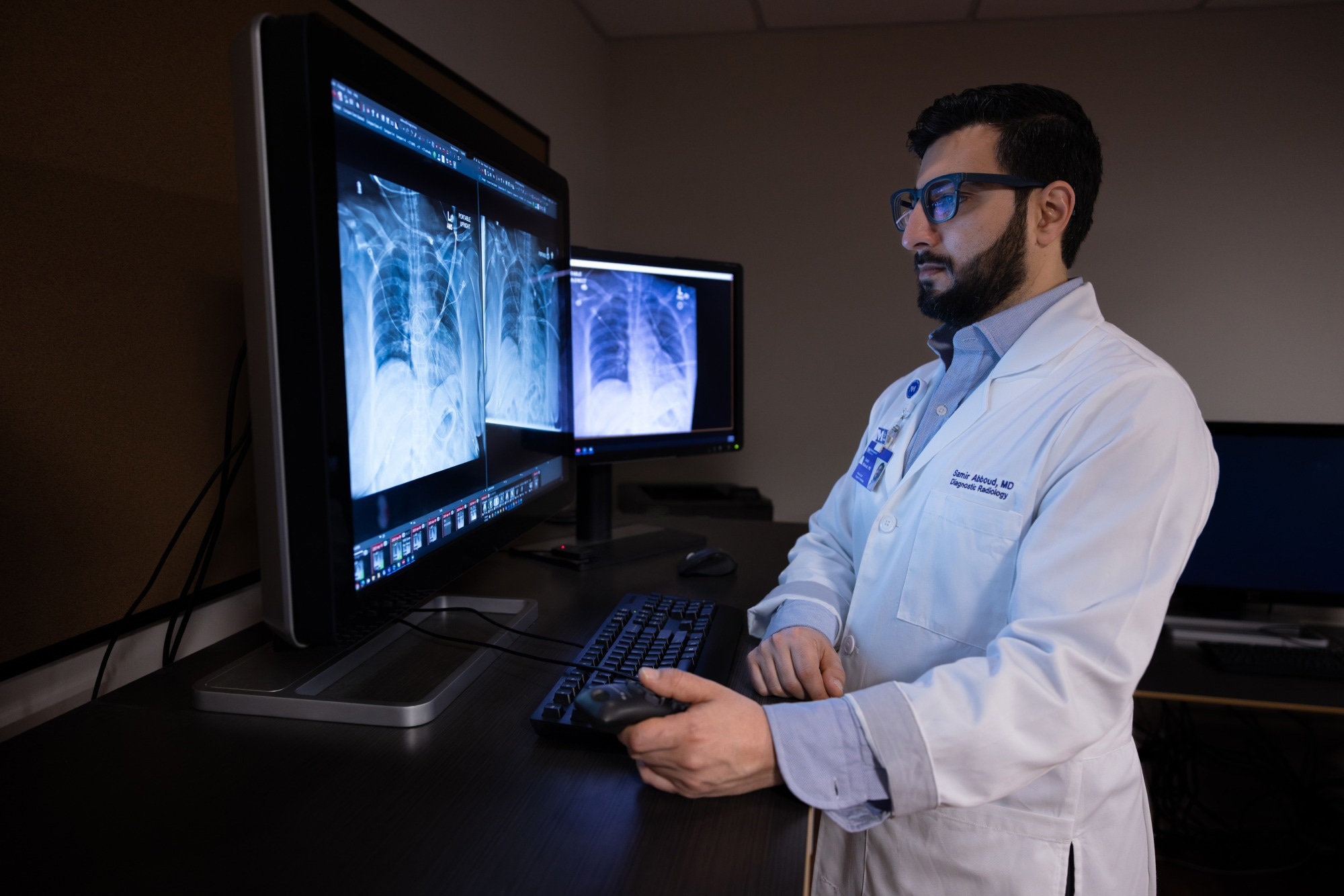According to a significant new study, a first-of-its-kind generative AI system created internally at Northwestern Medicine is transforming radiology by increasing efficiency, spotting potentially fatal diseases in milliseconds, and providing a ground-breaking remedy for the world's radiologist deficit. JAMA Network Open published the study on June 5th, 2025.
 Photo of Dr. Abboud in the radiology reading room. Image Credit: José M. Osorio/Northwestern Medicine
Photo of Dr. Abboud in the radiology reading room. Image Credit: José M. Osorio/Northwestern Medicine
This is, to my knowledge, the first use of AI that demonstrably improves productivity, especially in health care. Even in other fields, I haven’t seen anything close to a 40% boost.
Dr. Mozziyar Etemadi, Study Senior Author and Assistant Professor, Anesthesiology, Northwestern University
Over five months in 2024, the AI system was implemented in real-time throughout the Northwestern Medicine network, which consists of 11 hospitals. During this time, almost 24,000 radiological reports were examined. Next, Etemadi's group contrasted clinical accuracy and radiograph report generation times with and without the AI technology.
Consequently, radiograph report completion efficiency increased by an average of 15.5%, with some radiologists reporting increases of up to 40%, without sacrificing accuracy. Unpublished follow-up work demonstrates up to 80% efficiency increases, making the instrument compatible with CT scans.
Radiologists could return diagnoses significantly quicker because of the time savings, especially in urgent situations where every second matters.
According to the study authors, this is the world's first generative AI radiology tool to be incorporated into a clinical workflow. It is also the first time that a generative AI model has shown great accuracy and enhanced efficiency across all X-rays, from skulls to toes.
‘It Doubled the Efficiency’
Unlike other limited AI systems that only detect a specific issue, Northwestern's holistic model examines the full X-ray or CT scan. It then creates a report that is 95% complete and specific to each patient, in the radiologist's preferred reporting style, for the radiologist to use, evaluate, and finish. These reports summarize critical results and provide a framework to help radiologists diagnose and treat patients.
For me and my colleagues, it’s not an exaggeration to say that it doubled our efficiency. It’s such a tremendous advantage and force multiplier.
Dr. Samir Abboud, Study Co-Author and Chief of Emergency Radiology, Northwestern Medicine
He also the Clinical Assistant Professor of Radiology at Feinberg.
Flagging Life-Threatening Conditions
In addition to increasing efficiency, the AI system detects life-threatening conditions such as pneumothorax (collapsed lung) in real time, before a radiologist examines the X-rays. As the AI model generates reports for each image, an automated program evaluates those reports for significant discoveries and compares them to patient information. If the system detects a new problem that requires rapid attention, it may notify radiologists.
Abboud added, “On any given day in the ER, we might have 100 images to review, and we don’t know which one holds a diagnosis that could save a life. This technology helps us triage faster so we catch the most urgent cases sooner and get patients to treatment quicker.”
The Northwestern team is also developing an AI algorithm to detect possibly missed or delayed diagnoses, such as early-stage lung cancer.
Etemadi stated, “Having a draft report available, even before it is viewed by the radiologist, offers a simple, actionable datapoint that can be quickly and efficiently acted upon. This is completely different than traditional triage systems, which need to meticulously be trained one by one on each and every diagnosis.”
Much of the study was carried out by his hospital-based engineering team at Northwestern Medicine's Information Services department, where Etemadi also serves as the clinical director of advanced technologies.
‘No Need to Rely on Tech Giants’
Northwestern engineers created their own system from the ground up, utilizing clinical data from the Northwestern Medicine network rather than modifying big, internet-trained models like ChatGPT. Because of this, the team was able to develop a lightweight, agile AI model that was faster, more accurate, and used fewer processing resources. It was created especially for Northwestern radiology.
There is no need for health systems to rely on tech giants.
Dr. Jonathan Huang, Medical Student, University of Feinberg
“Our study shows that building custom AI models is well within reach of a typical health system, without reliance on expensive and opaque third-party tools like ChatGPT. We believe that this democratization of access to AI is the key to drive adoption worldwide,” Etemadi added.
Etemadi oversees a Bell Labs-style engineering team integrated into the healthcare system and has attracted top talent from major tech and finance.
Etemadi said, “My proudest achievement is building such a strong interdisciplinary team that can execute on the health system’s highest priorities. We are not just pushing health care AI forward we are advancing the fundamentals of AI at a fraction of the cost of the big AI labs. This is the start of the DeepSeek moment for health care AI.”
Solving a Global Shortage
Radiology is becoming one of health care's most significant bottlenecks. By 2033, the United States is predicted to have a shortfall of up to 42,000 radiologists, as imaging volumes climb by up to 5% per year while radiology residency opportunities grow by just 2%.
Northwestern's AI technology provides a solution, enabling radiologists to eliminate backlogs and provide findings in hours rather than days. While the technology is impressive, it will not replace humans.
Abboud added, “You still need a radiologist as the gold standard. Medicine changes constantly new drugs, new devices, new diagnoses and we have to make sure the AI keeps up. Our role becomes ensuring every interpretation is right for the patient.”
The Northwestern Medicine technique has been granted two patents, and more patents are pending clearance at different phases. The tool's commercialization is still in its infancy.
Video Credit: Northwestern Medicine
Journal Reference:
Huang, J., et al. (2025) Efficiency and Quality of Generative AI–Assisted Radiograph Reporting. JAMA Network Open. doi.org/10.1001/jamanetworkopen.2025.13921.